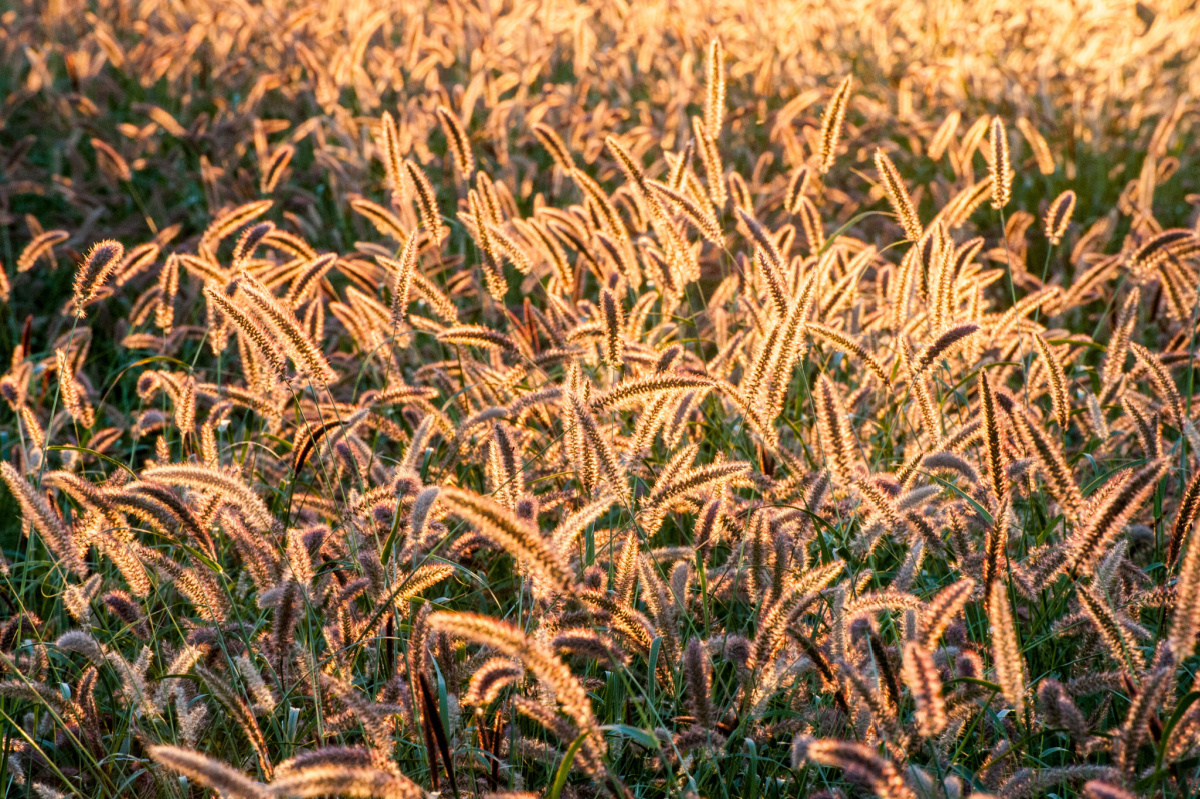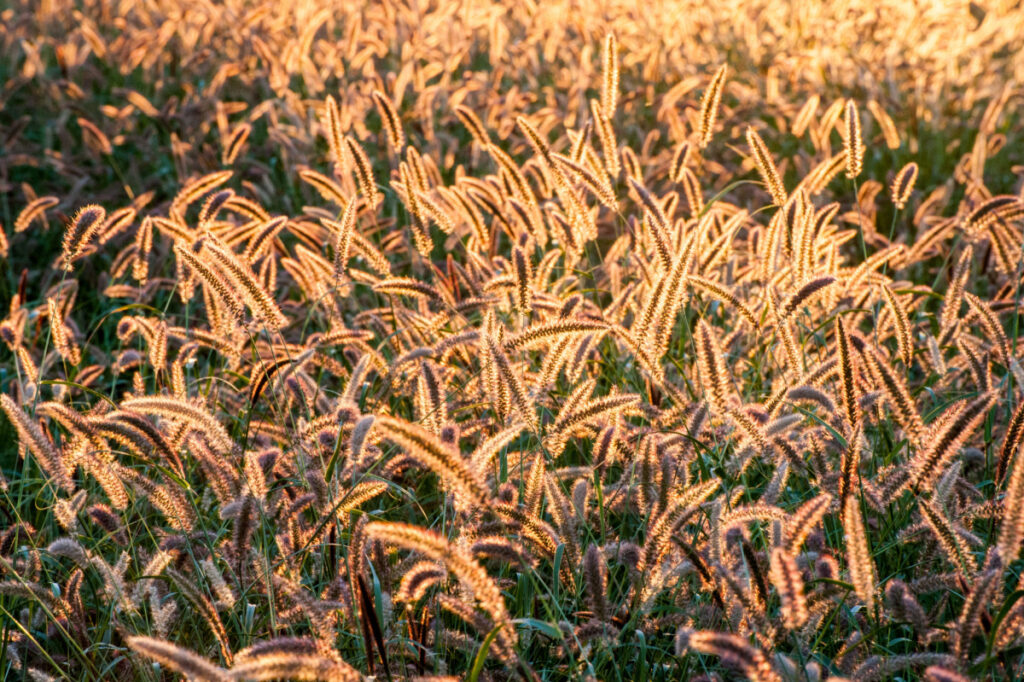Swaying and dancing in the breeze, ornamental grasses steal the show with their airy seed heads and autumnal hues.

As a tribute to the brilliant fall leaves of autumn, the movement of ornamental grasses contributes to the end of the season.
Ornamental grasses in mass plantings have layers of colorful movement that bid farewell to birds migrating south.

And the seed-laden hairs welcome hardy wildlife and provide snacks for passers-by.
Inspired by the native grasses and sedges that grace our river valley, ornamental grasses in colors of gold, bronze and flame are at their peak in the fall.

Curving, curving, swaying ornamental grasses provide a graceful contrast to the vibrant, drooping foliage.

Dramatic standing ovations of stiff, upright ornamental grasses stand out among the bare branches.

The perfect complement for eye candy in any season in the garden, ornamental grasses pair perfectly with our favorite fall-flowering perennials.

In fall, ornamental grasses are superb in mass plantings, glorious as single specimens, spectacular in the understory, and especially beautiful in group plantings and borders.

Whether upright or cascading, perennial and annual ornamental grasses are ideal for fall hanging baskets.
Try them with fall blooming mums or other favorite fall potted plants.

Many ornamental grasses add drama to fall displays and fall-themed bouquets with their long, slender leaves and interesting seed heads.

With long bloom times and fall shows, most ornamental grasses do well late in the season.
Radiating above the rest, here are our top ornamental grasses that steal the show in the fall.
Contents
12 ornamental grasses that steal the show in the fall
1. sedge (Carex sp.)
Form is function for sedge varieties. Cascading mounds of fine, narrow foliage, the hallmark of the large sedge genus of 2,000 species.

Our main competitors are two varieties native to North America, foothill sedge, Sedge tumulicolafor zones 8 to 10, and Pennsylvania Sedge, Sedge pensylvanicahardy in zones 3 through 9. Each creates structurally interesting arched mop heads over 12 inches.
Craving deeper fall color? sad evergold, Carex oshimensis ‘Evergold’ from Japan has a warm yellow hue, and Bronzite Sedge, sedge is coming of New Zealand is a narrow-leaved bronze mound.

Sedges like full sun to partial shade and prefer well-drained soil.
2. Blue Oat Grass (Helictotrichon sempervirens)

This perfectly radiant teal evergreen grass forms in clumps with seed heads that dance like feathers in the fall.
Sturdy steel blue foliage tapers to a fine point, adding contrast to fall-themed garden displays.
In zones 4 through 9, bushy clumps grow two feet by three feet wide.
3. Pink muhly grass (Capillary Muhlenbergia)

Seemingly invented in fairy tale dreams, Pink Muhly Grass bursts into fall with soft, fuzzy pink flowers.
Plant pink Muhly grass in clumps or mass plantings to show the cloud effect.
The 10-foot-tall broad grasses bloom pink in the fall and turn brown, but persist through winter.
This native plant is extremely drought tolerant once established and thrives in zones 6 through 9.
4. Reed Grass Feather (Calamagrostis x acutiflora)

Extremely popular, Feather Reed Grass is probably the best known of the ornamental grasses. They might even be entirely responsible for the popularity of ornamental grasses!
Most famous of all, ‘Karl Foerster’ stands out from the crowd with strong upright growth that is often still standing in spring.
‘Karl Foerster’ is tall and slender, 3 to 5 feet tall with long golden seed heads. It likes rich, moist soil, full sun, and zones 4 to 7.

‘Avalanche’ deserves a mention, tolerating wetter soil and offering interest with its variegated green leaves.
5. Blue Fescue (glaucous festuca)

Consistency is the virtue of blue fescues with an even, well-bred habit.
Small domes 8 to 12 inches high and wide have finely textured needle-like blades.
Wonderful as an underplant, blue fescue stands out among shrubs with colorful bark or foliage and late blooming perennials.
These fast-growing perennials take on beautiful color in full sun, tolerate drought but prefer regular watering, and survive in zones 4 to 8.
6. Grass Fountain (Pennisetum sp.)

There may be some discussion about which is more popular, fountain grass or reed grass.
Fountain grass is an arching ornamental grass often grown as an annual and some varieties are hardy enough to grow as perennials.
Some are small, like ‘Little Bunny’ measuring just 18 inches (45 cm), while others have stems up to 8 feet long. It’s a tree where I come from!
In the fall, it’s the colorful, arching foxtail-like flower heads that adorn these beautiful grasses that keep them popular in landscape and container plantings.

Some varieties can be invasive, escape cultivation, and create competition for habitats for native plants and wildlife.
A popular variety is Purple Fountain Grass, Pennisetum setaceum ‘Rubrum’loved for its soft feathers dancing in the autumn breeze.
Grown as an annual in cooler climates than zones 8 to 11, this variety does not reseed and grows 2 to 4 feet tall.
7. Blue Grass ‘Blonde Ambition’ (Bouteloua gracilis ‘Blond Ambition’)

A fall grass worth mentioning is Blonde Ambition, loved for its ease of maintenance.
Hardy in zones 4 through 9, Blue Grama Grass holds quivering horizontal seed heads on stiff 10-foot stems.
While the seed heads persist through fall, this drought-tolerant grass thrives in full sun to partial shade and looks great in low-maintenance gardens.
8. Red Switch Grass (panicum virgatum)

Switchgrass, a tall grass native to North America, has a strong upright habit that provides a nice vertical accent in the garden.
In the fall, the green grass turns into bold reds, yellows, oranges and burgundy.
Tolerant of both wet and dry conditions, switchgrass grows 3 to 6 feet tall with partial sun in zones 5 to 9.
A favorite ornamental grass in the fall, ‘Shenandoah’ is known for its showiest fall colors.
9. The Big Blue Voice (Andropogon gerardii)

Big Bluestem is a native grass that grows upright and forms a tight clump 3 to 8 feet tall.
In the fall, the blue-green leaves of Big Bluestems turn rust-colored.
Although shorter, the ‘Red October’ variety turns red like a candy apple and reaches a height of 5 to 6 feet.
Named for its gentle grace in the wind, ‘Windwalker®’ turns pink and purple in the fall.
Big Bluestem needs full sun. They prefer moist to medium soils, but can be very drought tolerant if needed once established.
Hardy in zones 3 through 9, Big Bluestem is a tall, upright native grass that sways gracefully in the fall winds.
Edible ornamental grasses: maize, sorghum and millet!

Ornamental garden grasses are valued for providing habitat and a food source for wildlife in addition to their many attributes.
But humans have been eating grasses and grass seeds for millions of years.
And as humans, we have grown some absolutely stunning edible ornamental grasses!
When harvesting ornamental plant food, you can choose to avoid herbicides, pesticides, and synthetic fertilizers.
10. millet (Pennisetum glaucum)

If Pennisetum sounds familiar, that’s because it’s the same genus name as Fountain Grass.
Pennisetum glaucum ‘Purple Majesty’ was developed as an ornamental and won the 2003 All-America Selections Gold Medal.
Many annual ornamental varieties have been developed from the humble millet, one of the oldest cultivated cereals.
Ornamental millet produces large flower heads 8 to 40 inches long that make perfect natural bird feeders.
Making a showy accent plant, ornamental millet grows 2 to 5 feet tall with rich foliage and long, cylindrical inflorescences.
11. Corn (Zea Mays)

An excellent annual ornamental plant, pedunculate corn plants come in countless varieties.
Terminal acorns and multicolored stems are used in autumn displays.
Many varieties have variegated, striped, multicolored, or visually interesting foliage that improves in the fall.
A unique plant, corn makes an unusual accent or border plant in the garden.
12. Sorghum broomcorn (Bicolor Sorghum)

The huge 24 to 36 inch tall seed heads of this tall cousin of corn make a lovely fall addition to the garden.
The multicolored seed heads are loose and rise to the top of very tall grasses in the fall.
Plants are annuals and mature in 100-110 days, just in time for fall decorating!

Invasive species of ornamental grasses
 japanese blood grass
japanese blood grassMany of us gardeners like to try new varieties, colors, and ideas, but we always want to make sure we’re growing things that don’t spread so freely that they escape cultivation.
Invasive plants that escape into the natural environment compete with and displace native plants that also serve as food sources for wildlife, birds and pollinators.
Avoid planting these aggressive or invasive ornamental grasses in high-risk areas.
- Maidenweed (Miscanthus sinensis)
- Pampas grass (Cortaderia selloana)
- Japanese blood grass (Imperata cylindrica ‘Rubra’)
- Giant reed (Arundo donax)
- Weeping love grass (Eragrostis curvula)
At the end of the season
All good things come to an end. One of the things we love most about fall is that it marks the end of the spring and summer gardening season. A time to enjoy the fruits of labor. But it will also affect the warm, calm and comfortable periods of winter.

Even as winter approaches, ornamental grasses look great covered in frost, provide structure in the conservatory, and provide habitat and food sources for wildlife.

Beyond their fall prowess, ornamental grasses can be left to grab or be harvested for use as dried flower crafts and winter decoration.
